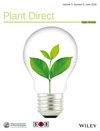Non‐destructive, whole‐plant phenotyping reveals dynamic changes in water use efficiency, photosynthesis, and rhizosphere acidification of sorghum accessions under osmotic stress
IF 2.3
3区 生物学
Q2 PLANT SCIENCES
引用次数: 0
Abstract
Noninvasive phenotyping can quantify dynamic plant growth processes at higher temporal resolution than destructive phenotyping and can reveal phenomena that would be missed by end‐point analysis alone. Additionally, whole‐plant phenotyping can identify growth conditions that are optimal for both above‐ and below‐ground tissues. However, noninvasive, whole‐plant phenotyping approaches available today are generally expensive, complex, and non‐modular. We developed a low‐cost and versatile approach to noninvasively measure whole‐plant physiology over time by growing plants in isolated hydroponic chambers. We demonstrate the versatility of our approach by measuring whole‐plant biomass accumulation, water use, and water use efficiency every two days on unstressed and osmotically stressed sorghum accessions. We identified relationships between root zone acidification and photosynthesis on whole‐plant water use efficiency over time. Our system can be implemented using cheap, basic components, requires no specific technical expertise, and should be suitable for any non‐aquatic vascular plant species.非破坏性全株表型揭示渗透胁迫下高粱品种水分利用效率、光合作用和根圈酸化的动态变化
与破坏性表型分析相比,非侵入性表型分析能以更高的时间分辨率量化植物的动态生长过程,并能揭示仅靠终点分析无法发现的现象。此外,整株表型还能确定地上和地下组织的最佳生长条件。然而,目前可用的非侵入式全植株表型方法一般都很昂贵、复杂且非模块化。我们开发了一种低成本、多功能的方法,通过在隔离的水培室中种植植物,非侵入式地测量整个植物的生理机能。我们每两天对未受胁迫和受渗透胁迫的高粱品种进行一次全株生物量积累、水分利用和水分利用效率的测量,证明了我们的方法具有多功能性。我们确定了根区酸化和光合作用对全株水分利用效率随时间变化的关系。我们的系统可以使用廉价的基本组件来实现,不需要专门的技术知识,应该适用于任何非水生维管植物物种。
本文章由计算机程序翻译,如有差异,请以英文原文为准。
求助全文
约1分钟内获得全文
求助全文
来源期刊

Plant Direct
Environmental Science-Ecology
CiteScore
5.00
自引率
3.30%
发文量
101
审稿时长
14 weeks
期刊介绍:
Plant Direct is a monthly, sound science journal for the plant sciences that gives prompt and equal consideration to papers reporting work dealing with a variety of subjects. Topics include but are not limited to genetics, biochemistry, development, cell biology, biotic stress, abiotic stress, genomics, phenomics, bioinformatics, physiology, molecular biology, and evolution. A collaborative journal launched by the American Society of Plant Biologists, the Society for Experimental Biology and Wiley, Plant Direct publishes papers submitted directly to the journal as well as those referred from a select group of the societies’ journals.
 求助内容:
求助内容: 应助结果提醒方式:
应助结果提醒方式:


